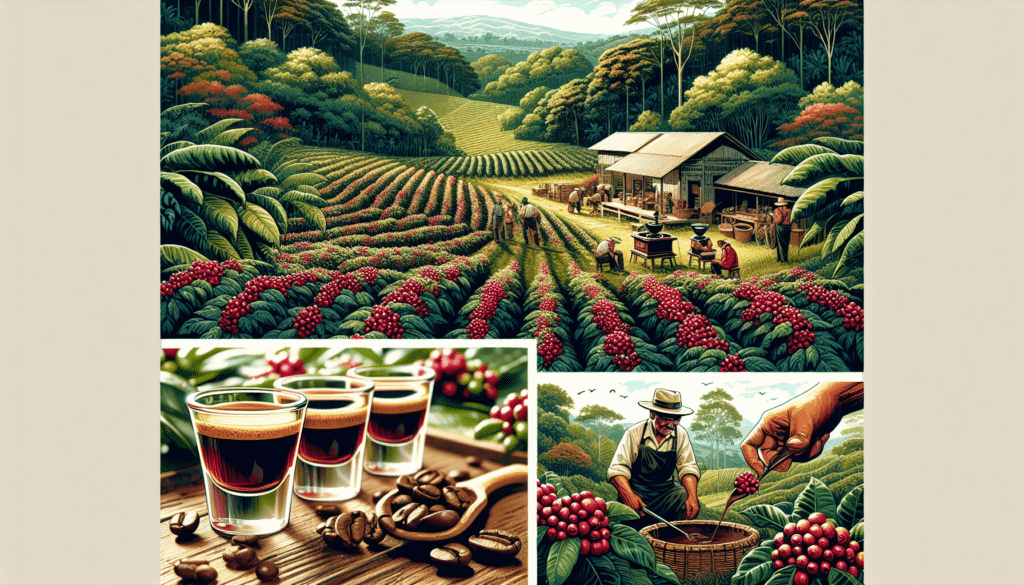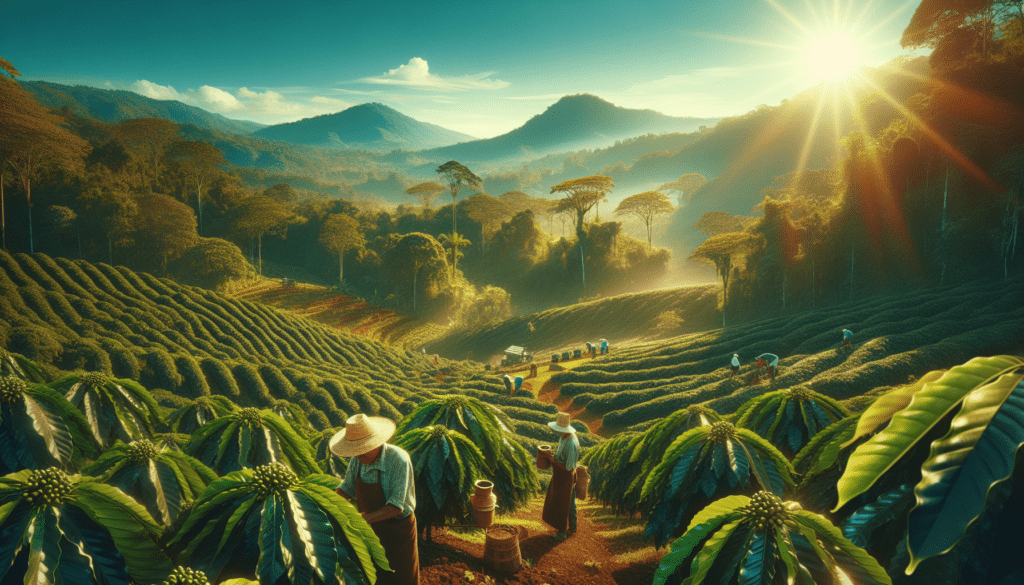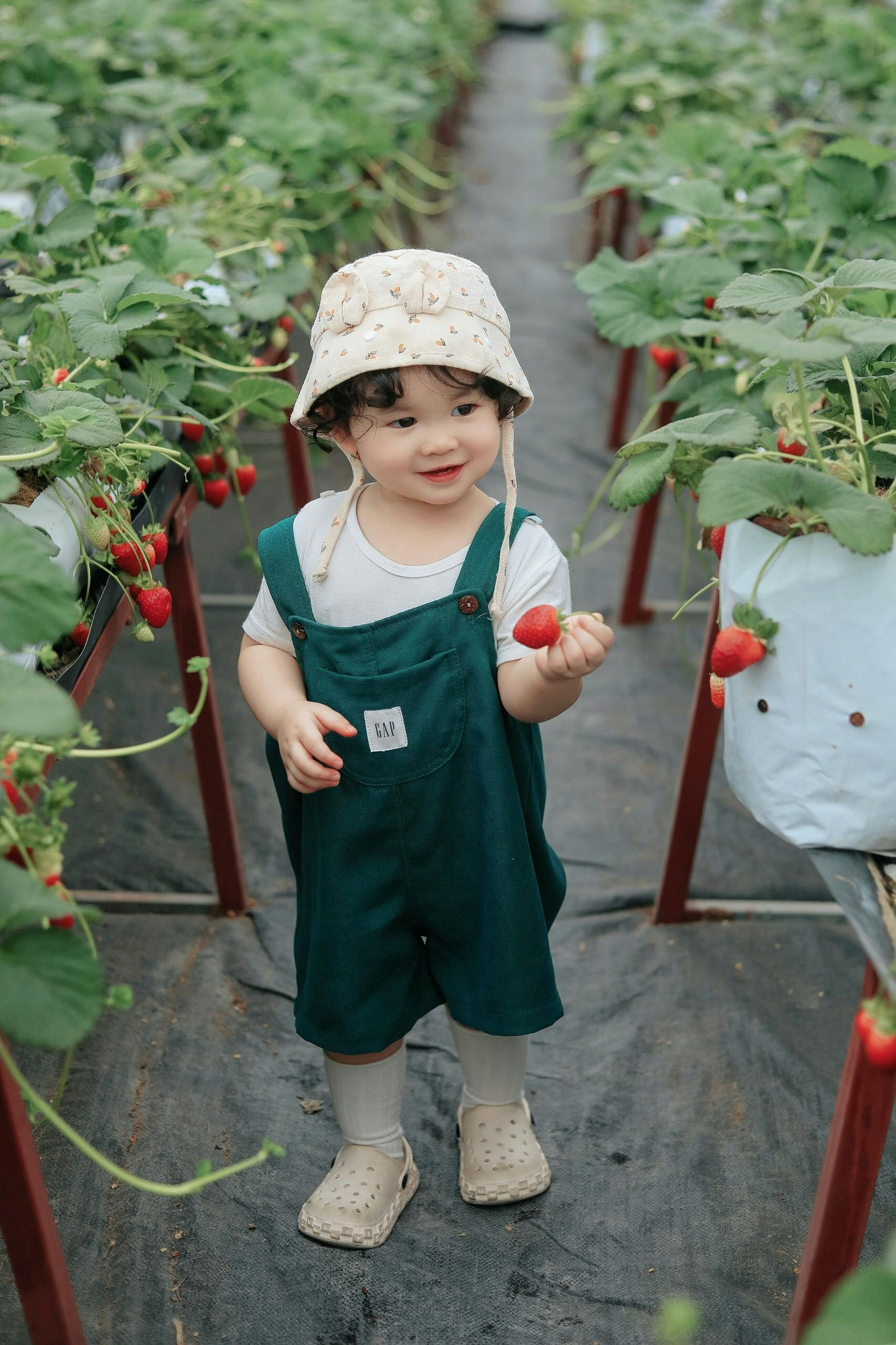Imagine yourself strolling through lush green fields, breathing in the enticing aroma of freshly roasted coffee beans, and sipping on a perfectly brewed cup of java. If this sounds like your idea of paradise, then Costa Rica is the ultimate destination for you. In this article, you will discover the best ways to explore the enchanting coffee plantations nestled in the heart of Costa Rica. From immersive tours that let you witness the entire coffee production process, to tasting sessions that will awaken your senses, this comprehensive guide will unlock a world of coffee heaven. Get ready to embark on a caffeine-fueled adventure like no other!
Understanding Costa Rican Coffee Culture
Costa Rican coffee culture is deeply rooted in the country’s history and economy. For centuries, coffee has played a significant role in shaping Costa Rican society. Understanding the history of coffee in Costa Rica is crucial to appreciating the significance it holds.
History of coffee in Costa Rica
Coffee was first introduced to Costa Rica in the late 18th century by Spanish settlers. The country’s fertile volcanic soil and ideal climate created the perfect conditions for coffee cultivation. Coffee plantations began to flourish, and by the early 19th century, coffee became the main export commodity for Costa Rica.
Importance of coffee in Costa Rican economy
Coffee has been a major contributor to the Costa Rican economy for over two centuries. It remains one of the country’s top export products, generating significant revenue and providing employment opportunities for thousands of Costa Ricans. The coffee industry has shaped the socio-economic landscape of Costa Rica, fueling development and growth.
The coffee harvest season in Costa Rica
The coffee harvest season in Costa Rica typically runs from November to March. During this time, coffee cherries are ripe and ready for picking. The harvest season is a busy and festive time in coffee-growing regions, with communities coming together to pick, process, and celebrate the bountiful harvest. This period offers visitors a unique opportunity to witness the coffee production process firsthand.
Why Costa Rican Coffee is unique
Costa Rican coffee stands out for its exceptional quality and flavor profile. The combination of rich volcanic soil, high altitudes, and specific microclimates contribute to the unique characteristics of Costa Rican coffee beans. They are known for their bright acidity, medium body, and notes of citrus, chocolate, and caramel. The strict regulations and meticulous processing methods employed by Costa Rican coffee growers further enhance the quality and consistency of the coffee produced.
Regions Famous for Coffee Plantations
Costa Rica is home to several coffee-growing regions, each offering its own distinct coffee flavors and experiences. Exploring these regions is a must for coffee enthusiasts and travelers seeking an authentic coffee plantation tour.
Central Valley
The Central Valley is the heart of Costa Rica’s coffee production. This region, known for its volcanic soil and moderate temperatures, produces some of the finest Arabica coffee in the country. Visitors to the Central Valley can experience the traditional coffee-growing methods and immerse themselves in the rich coffee culture.
West Valley
Located west of the capital city of San Jose, the West Valley is renowned for its specialty coffee. The region’s unique microclimate and high altitude result in beans with exquisite flavors and aromas. Coffee lovers can explore the picturesque coffee farms while learning about the innovative techniques used in this region.
Tarrazú
Tarrazú, located in the mountains of the Central Valley, is internationally recognized for its high-quality coffee. The region’s cool temperatures and optimal growing conditions produce beans with a distinctively bright acidity and floral undertones. Coffee enthusiasts can visit Tarrazú to witness the meticulous harvesting and processing methods employed by local farmers.
Brunca
Located in the southern region of Costa Rica, Brunca is known for its organic coffee production. The fertile soil and abundant rainfall in this region result in coffee beans with a rich, full-bodied flavor. Visitors can explore the sustainable farming practices embraced by Brunca’s coffee growers and indulge in the region’s exquisite coffee offerings.
Guanacaste
Guanacaste, famous for its stunning beaches and biodiversity, also boasts a growing coffee scene. The region’s volcanic soil and unique climate contribute to the distinct flavors found in Guanacaste’s coffee. Travelers can explore the coffee farms and enjoy the scenic beauty that this region has to offer.
Tres Ríos
Tres Ríos, located in the province of Cartago, is known for its award-winning coffee. The region’s high altitude, consistent rainfall, and volcanic soil create optimal conditions for producing exceptional coffee beans. Visitors can take part in guided tours, where they can learn about the intricate coffee production process and sample the finest Tres Ríos coffee.
Turrialba
The Turrialba region, situated in the lush mountains of Costa Rica, is renowned for its high-quality coffee. The rich volcanic soil and misty climate contribute to the unique flavor profile of Turrialba coffee. Travelers can explore the region’s coffee plantations while taking in the breathtaking scenery and learning about the coffee cultivation techniques employed here.
Orosi
Orosi Valley, located in the Cartago Province, is the oldest coffee-growing region in Costa Rica. This historic region offers visitors a glimpse into the country’s coffee heritage. The combination of ideal altitudes and temperatures results in coffee beans with a well-balanced flavor and pleasant acidity. Visitors can immerse themselves in the local coffee culture and explore the traditional methods of coffee production.

Planning Your Coffee Plantation Tour
Planning your coffee plantation tour in Costa Rica requires some consideration to ensure you make the most of your experience.
Best time to visit
The coffee harvest season, which typically runs from November to March, is an ideal time to visit Costa Rica’s coffee plantations. During this period, you can witness the bustling activity of coffee picking and participate in the traditional coffee production process.
Considering the weather
Costa Rica’s climate can vary based on the region and elevation. It is crucial to consider the weather when planning your coffee plantation tour. The dry season, from December to April, offers sunny and pleasant weather, while the green season, from May to November, provides lush landscapes and occasional rain showers. Choose a time that aligns with your weather preferences and desired experiences.
Accessing the coffee regions
Costa Rica’s coffee regions are scattered across the country and can be accessed by various means of transportation. Depending on your preferences and travel plans, you can choose to rent a car and drive to different coffee plantations, or opt for organized tours that provide transportation. Consider the logistics involved in reaching your desired coffee regions and plan accordingly.
Planning your itinerary according to your interests
Costa Rica offers a wealth of coffee plantation tours, each with its own unique offerings. Consider your interests and preferences when planning your itinerary. If you are passionate about sustainability, explore eco-friendly coffee plantations. If you are a coffee connoisseur, focus on regions known for their specialty coffees. Tailor your itinerary to match your interests and make the most of your coffee plantation tour.
Top Coffee Plantation Tours in Costa Rica
Costa Rica boasts numerous coffee plantation tours that offer visitors an immersive and educational experience. Here are some of the top coffee plantation tours to consider:
Doka Estate
Doka Estate, located in the Alajuela Province, is one of Costa Rica’s oldest and most recognized coffee plantations. Visitors to Doka Estate can enjoy guided tours that provide insight into the coffee production process, from seed to cup. The tour includes a visit to the estate’s coffee mill, as well as a tasting session of their aromatic coffees.
Finca Rosa Blanca
Finca Rosa Blanca, nestled in the mountains of Heredia, offers a unique coffee plantation experience coupled with luxury accommodations. Guests at Finca Rosa Blanca can indulge in guided tours that provide in-depth knowledge about the organic coffee production methods employed on the estate. The tour concludes with a coffee cupping session where visitors can sample a range of exquisite coffees.
Café Britt
Café Britt, located in the Central Valley, is a well-known name in the Costa Rican coffee industry. The plantation offers engaging coffee tours that educate visitors about the history and culture of coffee in Costa Rica. The tour includes a visit to the coffee roastery, where visitors can learn about the intricacies of coffee roasting, and a tasting session featuring Café Britt’s renowned coffees.
Café de Monteverde
Café de Monteverde, situated in the Monteverde Cloud Forest, provides visitors with a unique coffee experience amidst breathtaking natural surroundings. The coffee tour at Café de Monteverde takes visitors through the complete coffee production process, including picking, processing, and roasting. Participants also get to sample the plantation’s delicious coffees.
Espíritu Santo Coffee Tour
The Espíritu Santo Coffee Tour, located in Naranjo, offers an authentic and hands-on coffee experience. Visitors can accompany local coffee farmers as they pick and process coffee cherries. The tour provides insights into the traditional methods of coffee production and offers participants the chance to taste freshly brewed coffee.

What to Expect on a Coffee Plantation Tour
Embarking on a coffee plantation tour in Costa Rica promises a range of experiences that go beyond simply sipping a cup of coffee. Here’s what you can expect on a coffee plantation tour:
Understanding the coffee growing process
Coffee plantation tours in Costa Rica provide visitors with an opportunity to delve into the intricacies of coffee cultivation. Starting from the planting of coffee seeds to the nurturing of coffee plants, participants can learn about the various stages involved in growing coffee beans and gain a deeper understanding of the dedication and hard work required to produce a high-quality cup of coffee.
Learning about the coffee roasting process
Many coffee plantation tours include visits to coffee roasteries, where visitors can learn about the art of coffee roasting. Roasting plays a crucial role in bringing out the flavors and aromas of coffee beans. Participants can witness the roasting process and gain insights into how different roasting techniques can influence the taste profile of the final product.
Sampling different varieties of coffee
No coffee plantation tour is complete without the opportunity to sample different varieties of coffee. Visitors can taste a wide range of Costa Rican coffees, each with its own unique flavor notes and characteristics. Coffee aficionados can enhance their palate by discerning the subtle variations in acidity, body, and aroma across different coffee samples.
Interacting with the local coffee growers
One of the highlights of a coffee plantation tour is the chance to interact with the local coffee growers. Visitors can engage in conversations with the farmers, learning about their experiences, traditions, and the challenges they face in the coffee industry. This firsthand interaction allows for a deeper appreciation of the passion and knowledge that goes into producing Costa Rican coffee.
Preparations for the Tour
Before embarking on a coffee plantation tour in Costa Rica, it is essential to make the necessary preparations to ensure a comfortable and enjoyable experience.
What to wear
Comfortable clothing and footwear are key when visiting coffee plantations. Opt for lightweight and breathable clothing, as plantations can get hot and humid. Closed-toe shoes are recommended to protect your feet during tours that involve walking through coffee fields and processing areas.
Things to carry
When heading out for a coffee plantation tour, it is advisable to carry a few essentials. Sunscreen, a hat, and sunglasses are necessary to protect yourself from the sun. It is also useful to have a refillable water bottle to keep hydrated throughout the tour. Lastly, a camera or smartphone can capture the picturesque landscapes and memorable moments during your visit.
Health and safety precautions
While coffee plantation tours are generally safe, it is essential to take necessary health and safety precautions. Apply insect repellent to protect yourself from mosquitoes and other insects. If you have any allergies, inform the tour guides in advance. Additionally, be cautious of uneven terrain and follow all instructions provided by the guides to ensure a safe and enjoyable experience.

Accommodations Near Coffee Plantations
Costa Rica offers a variety of accommodations near coffee plantations, catering to different preferences and budgets. Whether you are seeking luxury, budget-friendly, or eco-friendly options, there are accommodations to suit every traveler’s needs.
Luxury accommodations
For those looking to indulge in luxury, there are upscale resorts and boutique hotels located near coffee plantations. These accommodations offer world-class amenities, breathtaking views, and a range of activities and experiences to enhance your stay. Some luxury options include resorts situated within coffee estates, allowing guests to immerse themselves in the coffee culture while enjoying luxurious comforts.
Budget-friendly options
Travelers on a budget can find affordable guesthouses, hostels, and lodges near coffee plantations. These accommodations provide comfortable rooms and basic amenities at more affordable rates. Budget-friendly options offer travelers the opportunity to experience the charm of Costa Rica’s coffee regions without breaking the bank.
Eco-friendly accommodations
Costa Rica is known for its commitment to sustainable tourism. There are several eco-friendly accommodations near coffee plantations that prioritize environmental conservation and minimize their carbon footprint. These accommodations utilize renewable energy sources, practice responsible waste management, and incorporate eco-friendly practices into their operations. Staying at an eco-lodge or sustainable hotel offers visitors the chance to contribute to the preservation of Costa Rica’s natural beauty.
Proximity to coffee plantations
When selecting accommodations, consider their proximity to coffee plantations. Stay in accommodations that allow easy access to the coffee regions you wish to explore. This ensures you can maximize your time spent on tours and minimize travel time between destinations, allowing for a more convenient and immersive coffee plantation experience.
Culinary Experiences on the Coffee Tour
Costa Rican coffee tours go beyond just exploring the coffee-making process. Visitors can also indulge in unique culinary experiences inspired by the flavors of coffee.
Tasting coffee-infused cuisine
Coffee-infused cuisine is a highlight of coffee plantation tours in Costa Rica. Many coffee tours include the opportunity to taste dishes and desserts made with coffee as a key ingredient. From savory coffee-rubbed meats to delectable coffee-infused desserts, these culinary delights bring together the rich flavors of Costa Rican coffee with traditional local ingredients.
Cooking classes featuring coffee
Some coffee plantations offer cooking classes where visitors can learn to incorporate coffee into their own dishes. These hands-on experiences allow participants to learn from skilled chefs who demonstrate creative ways of incorporating coffee into various recipes. Whether it’s a coffee-infused sauce or a delectable coffee dessert, these cooking classes offer unique insights into the versatile uses of coffee in the culinary world.
Local food to try around the coffee plantations
When visiting coffee plantations, exploring the local cuisine is a must. Many coffee-growing regions in Costa Rica offer a range of traditional dishes that showcase the country’s culinary heritage. From hearty stews and rice dishes to fresh seafood, travelers can savor the flavors of Costa Rican cuisine and experience the unique blend of influences from indigenous cultures, Spanish settlers, and African slaves.

Expanding Your Tour: Beer and Chocolate
While coffee is undoubtedly the star attraction in Costa Rica, there are other beverage and food experiences that complement the coffee tour and allow visitors to explore different aspects of the country’s gastronomy.
Costa Rica’s burgeoning craft beer scene
Costa Rica’s craft beer scene has been rapidly growing in recent years, offering beer enthusiasts a unique tasting experience. The country is home to a variety of local breweries that produce a wide range of artisanal beers. Visitors can embark on beer tours, visiting breweries and tasting rooms to sample the diverse flavors and styles of Costa Rican craft beer.
Chocolate tours and tastings
Chocolate lovers will delight in the opportunity to explore the world of Costa Rican chocolate on chocolate plantation tours. These tours take visitors through the stages of chocolate production, from cocoa cultivation to the creation of mouth-watering chocolate bars. Participants can indulge in chocolate tastings, where they can savor the complex flavors and aromas of Costa Rican chocolate.
Exploring other plantation tours
Costa Rica is known for its diverse agricultural landscape, and beyond coffee and chocolate, there are other plantations worth exploring. Visitors can embark on tours of sugar cane plantations, pineapple farms, or banana plantations, gaining insights into the cultivation and production processes of these various crops. These tours offer a well-rounded perspective of Costa Rica’s agricultural traditions and their contribution to the country’s economy.
Responsible Tourism in Coffee Plantations
As visitors, it is essential to practice responsible tourism when exploring Costa Rica’s coffee plantations. Here are some ways you can contribute positively:
Sustainable coffee production
Support coffee plantations that prioritize sustainable and ethical practices. Look for certifications such as Fair Trade or Rainforest Alliance, which ensure that farmers receive fair compensation and adopt environmentally friendly farming methods. By choosing to visit and purchase coffee from these plantations, you directly contribute to the preservation of Costa Rica’s coffee heritage and sustainable farming practices.
Supporting local communities
When visiting coffee plantations, opt for tours and accommodations that work closely with local communities. This helps support the livelihoods of people living in coffee-growing regions. Additionally, consider purchasing souvenirs or coffee directly from local producers, as this ensures a more direct benefit to the community.
Purchasing coffee as souvenirs
Bringing home freshly roasted Costa Rican coffee is a delightful way to savor the flavors of your coffee plantation tour and share the Costa Rican coffee experience with friends and family. Purchasing coffee as souvenirs supports local coffee growers and promotes the continuation of traditional coffee cultivation methods that have been passed down through generations.
Being a responsible tourist
Respect the environment and the cultural heritage of the coffee-growing regions you visit. Follow all guidelines provided by tour guides and local communities. Minimize your ecological impact by disposing of waste responsibly and being mindful of water and energy conservation. By being a responsible tourist, you can help preserve the beauty of Costa Rica’s coffee regions for future generations to enjoy.
In conclusion, exploring coffee plantations in Costa Rica offers a unique opportunity to immerse oneself in the rich coffee culture and witness the journey from bean to cup. From learning about the history of coffee in Costa Rica to visiting various coffee-growing regions and indulging in culinary experiences, a coffee plantation tour ensures an unforgettable experience for coffee enthusiasts and travelers alike. By practicing responsible tourism and supporting local communities, visitors can contribute to the sustainability of Costa Rica’s coffee industry and further enhance their travel experience.








0 Comments